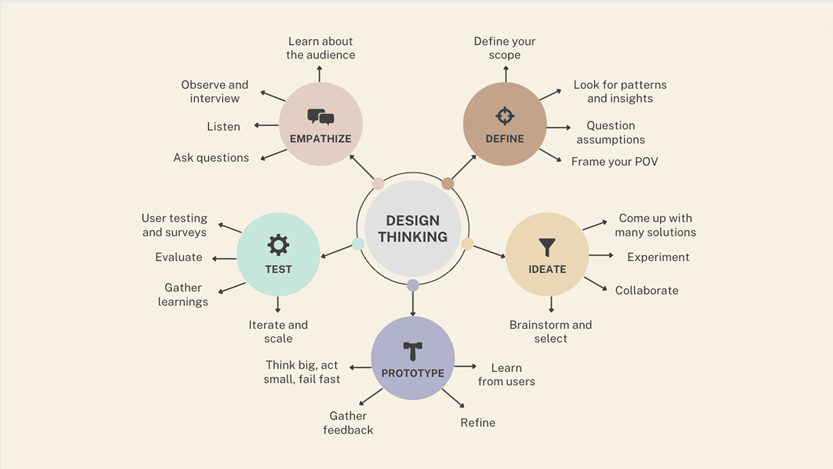Introduction
Brainstorming is a method of generating ideas and sharing information to solve any problem in which participants are encouraged to think without interruption. Brainstorming is a group activity where each participant shares ideas as soon as they come to mind. At the end of the session, ideas are categorized and sequenced for ongoing action. Brainstorming is a group problem-solving method that involves creative ideas and solutions spontaneously. This technique is a free group discussion in which each member of the group is encouraged to think aloud and propose as many ideas as possible based on their diverse knowledge.
Brainstorming
The brainstorm technique is also know as Team idea mapping method, directed brainstorming, blossom method, flower method, among others.
Description
A.F.Osborn is the person who started the history of brainstorming in the 1930s to strengthen his work in advertising. Osborn published The Applied Imagination in 1957. He developed his theory by revealing that when the group members started to produce the ideas that came to their minds, they generated more ideas than the other members' ideas. The freer the ideas were, the better. Osborn claimed that with this method, when one is individual, he/she generates more ideas than being a group member.
A group of people sit together, generate ideas, and share their ideas with the group. Its purpose is to encourage free thinking, foster creativity, and promote the generation of new ideas. The content presupposes that the mutual stimulation of ideas begins with the goal of being as creative as possible in comfortable environments where people are together. Members then evaluate the ideas (Gail Kay, 1995).
Overall, the purpose of a brainstorm is to tap into the collective creativity and knowledge of a group, enabling the discovery of fresh perspectives, innovative solutions, and breakthrough ideas that may not have emerged through individual thinking alone.
Limitations:
In crowded groups, class management problems may occur.
How to implement these technique/tools
Preparation, before the session:
- Define brainstorming rules: By writing the list of rules to be shared with the students.
- Define the subject or problem: the teacher should define a topic. Students should have at least a little information about the topic.
During the session:
- 1-Introducing the brainstorming rules: By writing the list of rules on the whiteboard or sharing with the students, we can direct the class processes.
- 2-Stating the subject or problem: the teacher should present the topic for the class, for which there are no explicit materials in the book.
- 3-Expressing ideas: a person presents his/her idea and then the next person takes turns to do the same, hence a revolving current of expressing ideas.
- 4-Exhibiting ideas for combination and improvement: So far, many ideas have been presented. Now refine ideas, and similar, or inappropriate ones.
- 5-Evaluating ideas: Now we have several classified ideas. The whole process of problem solving; it is also one of the stages of idea- seeking, the latter itself being just one of the stages of creative problem-solving (HarirForoush and Sadeghi, 1389)
Follow-up after the session:
- Review and provide feedback on the ideas created.
- Facilitate reflective discussions where students can share their experiences and insights gained.
Examples and/or testimonials

https://www.canva.com/p/templates/EAE8WBTso3Y-mind-mapping-design-thinking-diagram-brainstorm/
Tools needed
Online: IdeaBoardz, Concept board, Evernote, Lucidspark, Miro, MindMup, Mindly, MindMeister, Coggle, Bubbl.us, LucidChart, MindNode, WiseMapping, The Awards.
Offline: Pen, paper, colourful pens.
Resources
Links:
- https://www.wework.com/ideas/professional-development/creativity-culture/effective-brainstorming-techniques
Videos:
- https://youtu.be/YXZamW4-Ysk
- https://youtu.be/OJ2guxkhvKU
Papers:
- https://www.sciencedirect.com/science/article/pii/S1877042813011129
- Murphy, L.R., Daly, S.R. & Seifert, C.M. Idea characteristics arising from individual
- brainstorming and design heuristics ideation methods. Int J Technol Des Educ 33,
- 337–378 (2023). https://doi.org/10.1007/s10798-021-09723-0
Books:
- Creative thinking and brainstorming JG Rawlinson
- Brainstorming and beyond: a user-centered design method by C Wilson
- Anke Brock, Emeline Brulé, Bernard Oriola, Philippe Truillet, Annie Gentes, et al.. A Method Story about Brainstorming with Visually Impaired People for Designing an Accessible Route Calculation System. ACM CHI 2016 - chi4good, May 2016, San José, United States. ffhal-01279207f
- Hryrfrosh et al., 2010 g. Hryrfrosh, M. Sadeghi Teaching Pattern of Brainstorming (2010)
- Rizi, C. E., Najafipour, M., & Dehghan, S. (2013). The effect of the using the brainstorming method on the academic achievement of students in grade five in Tehran elementary schools. Procedia-Social and Behavioral Sciences, 83, 230-233.
- Gail Kay, (1995),'Effective meetings through electronic brainstorming', Journal of Management Development, Vol. 14 Iss 6 pp. 4-25
- https://books.google.com.tr/books?id=YsnKE2JdlsQC&lpg=PP1&ots=MaKgygbex9&dq=types%20of%20brainstorming%20method&lr&hl=tr&pg=PR7#v=onepage&q=types%20of%20brainstorming%20method&f=true